How can you be so absolutely sure which is fake and which not, without testing? I have boxes of genuine power transistors bought at different times from different manu´s and they all look different, yet all work as advertised.
I would at least do some tests before running the risk to throw away perfectly good devices just because you don´t like the looks.
Jan
I would at least do some tests before running the risk to throw away perfectly good devices just because you don´t like the looks.
Jan
How can you be so absolutely sure which is fake and which not, without testing? I have boxes of genuine power transistors bought at different times from different manu´s and they all look different, yet all work as advertised.
I would at least do some tests before running the risk to throw away perfectly good devices just because you don´t like the looks.
Jan
I tested Cgs and Cgd for each, on the basis that it's a very easy test and will show differences between parts. The test was out by a factor of four for the fakes.
The genuine ones are from a tube of transistors that I've been using for years. While they haven't been particularly well tested (except for the Cgs and Cgd tests to obtain a benchmark), the other transistors in the tube have been extensively tested in amplifiers.
Regarding looks, the real Renesas parts are pretty rough. Markings on the fakes are much better. Just means that the people making the fakes have access to sophisticated laser marking tools.
Last edited:
I also checked my genuine Hitachi 2SJ162 and 2 SK1058 and found out, that all the physical characteristics (cut-outs and markers on the case) are identical to the renesas types on the right side of suzyj pictures, but the marking of the case is identical to those of the 'fake' sj162. With my low-cost transistortester Mega328 from China i tested the devices and it shows for example for a 2sk1058 a Cgs value of 570pf and a threshold voltage Ut of 0,45V. Since i own them more than 15 yrs, i think they are genuine.
If suzyj's devices are really fakes, why didn't you name the US supplier you buy it from. Maybe it's against the forum rules.
I'm seeing how the vendor responds to my claim. It's conceivable that they've bought them from a third party and don't know they're fakes.
Hi suzyj,
I also contacted vendors where counterfeit parts were bought and they refunded the money with one demanding that I cut the legs off the counterfeit parts. Reasonable since they were to be discarded and no one wants them to end up back in the system again. I usually use a mallet and anvil to permanently mark the fakes before I discard them. No matter how you do it, the non-genuine parts must not be allowed to be used by anyone.
Have you made contact with the vendor in this case?
-Chris
I've filed a "suspected not authentic" claim with eBay. I'm really surprised at people suggesting I use them for anything. I have no idea what they are. If I put them in an amp they're as likely to catch fire as work.
I quite like the idea of marking them to be sure they can't be sold again.
Sure you don' know. You didn't test those parts and until you do you won't know what they will catch - cotton swab is hardly a way to test a semiconductor.... I have no idea what they are. If I put them in an amp they're as likely to catch fire as work....
It could easily happen that you have IRFP240 or 2N3055 or something else that can find a good use in many circuits...
Or, if you don't have time for that, throw them away - you are a big girl and you obviously already got over it
Dissassembly photo. On the left are the two flavours of "2SJ162", on the right is the "2SK1058". They really need to learn how to mount die - they've done a dreadful job.
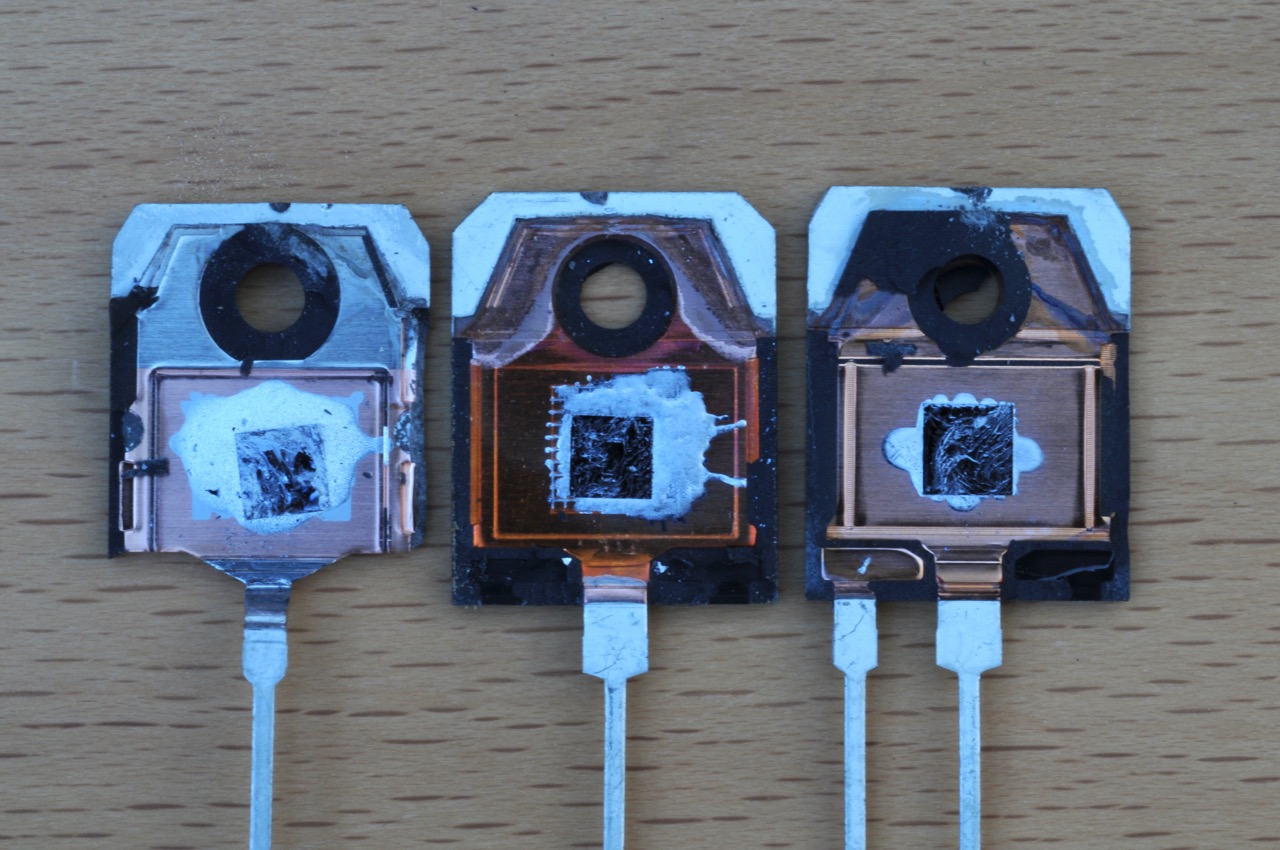
They definitely aren't lateral fets. Lateral fets need a "downbond" to connect the transistor source to the tab. There's no evidence of any bond to the tab on any of these. Here's a diagram I just found that neatly illustrates the difference. It also explains why vertical fets always have the tab as the drain, rather than the source - it's simply due to where the metalisation is for the drain and source. Lateral fets have all the metalisation on top of the die, as the current flows laterally across the face of the die. Vertical fets have current flowing through the die, hence metalisation on the back:
The vendor has refunded both purchase price and postage, and replied with "Hello I sold many of this item, without any complaint", so I guess there's a bunch of people out there wondering why their amplifiers don't work.

They definitely aren't lateral fets. Lateral fets need a "downbond" to connect the transistor source to the tab. There's no evidence of any bond to the tab on any of these. Here's a diagram I just found that neatly illustrates the difference. It also explains why vertical fets always have the tab as the drain, rather than the source - it's simply due to where the metalisation is for the drain and source. Lateral fets have all the metalisation on top of the die, as the current flows laterally across the face of the die. Vertical fets have current flowing through the die, hence metalisation on the back:
An externally hosted image should be here but it was not working when we last tested it.
The vendor has refunded both purchase price and postage, and replied with "Hello I sold many of this item, without any complaint", so I guess there's a bunch of people out there wondering why their amplifiers don't work.
Last edited:
Hi juma,
Your response isn't correct for one. She did test the parts and the differences between devices is both valid and decisive. I hope you think a little before responding to other members a little more.
As I said above, If a device is not as marked, it is a hazard and should be destroyed. I'm not going to ever change my viewpoint on that score. Would you use ammunition marked 0.223 cal in a 0.308 cal rifle? If it did chamber, you might see what a bursting case feels like. But if it was 0.308 cal, the person who grabbed them for a 0.223 cal might have trouble. Labeling is critical.
-Chris
Your response isn't correct for one. She did test the parts and the differences between devices is both valid and decisive. I hope you think a little before responding to other members a little more.
As I said above, If a device is not as marked, it is a hazard and should be destroyed. I'm not going to ever change my viewpoint on that score. Would you use ammunition marked 0.223 cal in a 0.308 cal rifle? If it did chamber, you might see what a bursting case feels like. But if it was 0.308 cal, the person who grabbed them for a 0.223 cal might have trouble. Labeling is critical.
-Chris
I tested Cgs and Cgd for each, on the basis that it's a very easy test and will show differences between parts. The test was out by a factor of four for the fakes..
OK, I missed that. Seems decisive enough!
Jan
Those are called "house numbers". These are used by companies when they either need to specify a transistor with certain parameters, or in the dark days of service, when they actually tried to hide what parts they are using.
You can do one of two things with those. Find a schematic for that piece of equipment and determine what the lowest possible rated device they would have been and use them in a project in a similar set of voltage and expected currents, or discard them. Personally, if I can't identify a part, I discard the thing as it is basically useless. If it failed in your project, was it being used beyond it's ratings, or is there something wrong with your circuit.
Do not use them to repair a stereo !! Especially not for someone else !!!
-Chris
You can do one of two things with those. Find a schematic for that piece of equipment and determine what the lowest possible rated device they would have been and use them in a project in a similar set of voltage and expected currents, or discard them. Personally, if I can't identify a part, I discard the thing as it is basically useless. If it failed in your project, was it being used beyond it's ratings, or is there something wrong with your circuit.
Do not use them to repair a stereo !! Especially not for someone else !!!
-Chris
They came fixed on a massive aluminum heatsink around 1cm thick at fixing area, and i have no idea from what a device were used in.I've seen a potential usage of that alu. heatsink for an amplifier, and now wonder if I can find them a place in anything..according their data which i can not find it according to their titlesThose are called "house numbers". These are used by companies when they either need to specify a transistor with certain parameters, or in the dark days of service, when they actually tried to hide what parts they are using.
You can do one of two things with those. Find a schematic for that piece of equipment and determine what the lowest possible rated device they would have been and use them in a project in a similar set of voltage and expected currents, or discard them. Personally, if I can't identify a part, I discard the thing as it is basically useless. If it failed in your project, was it being used beyond it's ratings, or is there something wrong with your circuit.
Do not use them to repair a stereo !! Especially not for someone else !!!
-Chris
Anyhow thank You for your spent time, and perhaps someone else might find useful data for them, even if not..they will rest for sure.
Again some transistors who i do not now if fake or not, but she are different then on other photo,s, it is difficult to tell, she came in protected package from wheel. Also difficult to solder, need to get to long before it do.
I do have experience that with ebay there more fakes as with Aliexpress, seems more secure and remove those who sell fakes.
I do have experience that with ebay there more fakes as with Aliexpress, seems more secure and remove those who sell fakes.
Attachments
Last edited:
Hi kees52,
Welcome to the lead-free solder world. You need to use a higher temperature for starters, and some liquid (electronic) flux would also help a lot.
-Chris
I have still the older lead solder, still not out of it, but when it is yes I need updates.
These transistors are just without solder so it have to do well, maybe some oxidation on the pins do trouble, I have clean that and it do work.
My solder iron can get high enough, for weller just a simpel upgrade.
regards
how older> so betetr such as wine, best bolted contact u can check or serch reserch nasa m, nearest cu hi current indsutria types and so on, just found all 12 high weigt onhand xxx parts.now only for art and dive on look and gold?plated pins ...ciao ciaoI have still the older lead solder, still not out of it, but when it is yes I need updates.
These transistors are just without solder so it have to do well, maybe some oxidation on the pins do trouble, I have clean that and it do work.
My solder iron can get high enough, for weller just a simpel upgrade.
regards
Do You have any idea what could be those unknown parts to me?, any specifications, or data sheet?
466 is the EIA corporate code for DELCO: audiophool.com/Misc/1962_EIA_codes.pdf
Last line looks like a date code and the number in the middle is a custom number. Delco was part of GM, may be numbers of them.
Onra
If your info is correct, the transistors are probably output types for car radios.
Possibly germanium such as OC35, AD149
Check with a transistor tester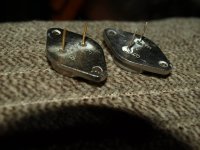
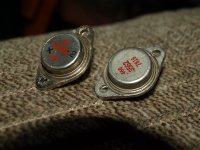
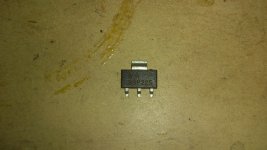
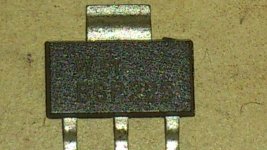
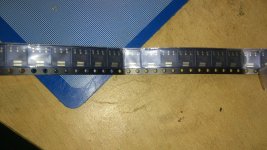
![IMAG0477[1].jpg](/community/data/attachments/555/555104-d4e9152b24506bb5417a07c765a45889.jpg)
![IMAG0475[1].jpg](/community/data/attachments/555/555092-1a66fa23e7b2176f4ca29e439bdec09e.jpg)
![IMAG0474[1].jpg](/community/data/attachments/555/555074-499bb5d2c9a2499e82346e0be14958d2.jpg)
![IMAG0473[1].jpg](/community/data/attachments/555/555060-d16ebb0119d99741d4fd02c2e4490bd5.jpg)
![IMAG0478[1].jpg](/community/data/attachments/555/555116-f3d9bf1f845313a7cf19febc8a2c45e3.jpg)